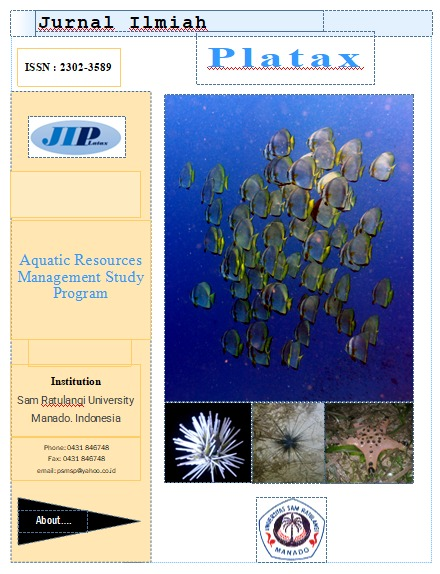Land Suitability and Carrying Capacity Analysis Of The Mangrove Ecotourism At Sarawet Village, East Likupang District, North Minahasa Regency
DOI:
https://doi.org/10.35800/jip.v12i2.57781Keywords:
Mangroves, Ecotourism, SarawetAbstract
The coastal area of Sarawet Village, East Likupang District, North Minahasa Regency, North Sulawesi Province has a mangrove forest covering an area of 379 hectares. Apart from being a living habitat for marine biota, this large area of mangrove is also an ecotourism destination. The purpose of this research is to determine the suitability of mangrove lands as ecotourism areas; Determine the ecological carrying capacity of the area for mangrove ecotourism activities; Assess public perceptions regarding the benefits of mangrove ecosystems and their potential to be developed as ecotourism destinations. The research method is a survey describing ecological, socioeconomic, institutional, and infrastructure conditions. Data collection is grouped into primary data and secondary data. Primary data collection was carried out through direct observation in the field by measuring the ecological potential of mangroves, visual observation of biota, and information from the community obtained directly at the research location through structured interviews with respondents. Based on the results of the study, the Tourism Suitability Index (IKW) value for the Sarawet Village mangroves was 2.73, which indicates the Very Suitable category for being developed as a mangrove river ecotourism area, as well as the public's perception of the benefits of the mangrove ecosystem and its potential to be developed as an ecotourism destination is very good. so it is hoped that this can improve the welfare of the existing community.
Keywords: Mangroves, Ecotourism, Sarawet
Abstrak
Kawasan pesisir Desa Sarawet Kecamatan Likupang Timur Kabupaten Minahasa Utara Provinsi Sulawesi Utara memiliki hutan mangrove seluas 379 hektar, keberadaan mangrove yang luas ini selain menjadi habitat hidup bagi biota laut juga sebagai tujuan ekowisata. Tujuan dan manfaat penelitian ini adalah menentukan kesesuaian lahan mangrove sebagai kawasan ekowisata; Menentukan daya dukung ekologis kawasan untuk kegiatan wisata mangrove ekowisata; Mengkaji persepsi masyarakat tentang manfaat ekosistem mangrove dan potensinya untuk dikembangkan sebagai tujuan ekowisata. Metode penelitian yang digunakan yaitu melakukan survei untuk mendeskripsikan kondisi ekologi, sosial ekonomi, kelembagaan dan infrastruktur. Pengumpulan data dikelompokkan menjadi data primer dan data sekunder. Pengumpulan data primer dilaksanakan melalui pengamatan langsung di lapangan dengan melakukan pengukuran potensi ekologi mangrove, pengamatan biota secara visual dan informasi dari masyarakat diperoleh langsung di lokasi penelitian melalui wawancara secara terstruktur dengan responden. Berdasarkan hasil kajian diperoleh nilai Indeks Kesesuaian Wisata (IKW) mangrove Desa Sarawet yakni sebesar 2,73 yang menunjukkan kategori Sangat Sesuai untuk dapat dikembangkan sebagai Kawasan ekowisata sungai mangrove, serta persepsi masyarakat tentang manfaat ekosistem mangrove dan potensinya untuk dikembangkan sebagai tujuan ekowisata adalah sangat baik sehingga diharapkan hal tersebut dapat meningkatkan kesejahteraan masyarakat yang ada.
Kata Kunci : Mangrove, Ekowisata, Sarawet
References
Bengen, D. G., 2000. Pedoman Teknis Pengenalan dan Pengelolaan Ekosistem Mangrove.
Pusat Kajian Sumberdaya Pesisir dan Kelautan Institut Pertanian, IPB, Bogor
Coccossis H, Mexa A, Collovini A. 2002. Defining, Measuring and Evaluating Carrying
Capacity in European Tourism Destinations. Greece (GR): Laboratory of
Environmental Planning, University of the Aegean.
Djamaluddin, R., 2018. Mangrove; biologi, ekologi, rehabilitasi, dan konservasi.
Manado: Unsrat Press.
Dahuri R., 2001. Pengelolaan Sumber Daya Wilayah Pesisir dan Lautan Secara Terpadu
Edisi Revisi. Jakarta (ID): PT. Pradnya Paramita.
Dahuri, R., 1996. Pengembangan Rencana Pengelolaan Pemanfaatan Berganda Hutan Mangrove di Sumatera. PPLH. Institut Pertanian Bogor.
Nazir M. 2009. Metode Penelitian. Cetakan ke-7. Bogor: Ghalia Indonesia
Nugraha HP, Indarjo A, Helmi M. 2013. Studi kesesuaian dan daya dukung kawasan untuk
rekreasi pantai di pantai panjang Kota Bengkulu. Journal of Marine Research.
(2):130-139.
Nugroho, I., 2011. Ekowisata dan pembangunan berkelanjutan. Yogyakarta: Pustaka Pelajar.
Yulianda F. 2007. Ekowisata Bahari Sebagai Alternatif Pemanfaatan Sumber daya Pesisir
Berbasis Konservasi. Seminar Sains Depatemen Manajemen Sumber daya Perairan.
Bogor: FPIK-IPB.
Iskandar, A., Schaduw, J.N.W., Rumampuk. N. D. C., Sondak, C. F. A., Warouw, V., & Rondonuwu, A. 2019. Kajian Kesesuaian Lahan Ekowisata Mangrove Di Desa Arakan Kabupaten Minahasa Selatan Sulawesi Utara. Program Studi Ilmu Kelautan. Fakultas Perikanan dan Ilmu Kelautan. Universitas Sam Ratulangi.
Lacher, R.C., Jodice, L.W., & Norman, W.C., 2013. The role of heritage and cultural
elements in coastal tourism destination preferences: a choice modeling–-based
analysis. Journal of Travel Research. 52(4):534–546.
Schaduw, J. N. W. 2015. Keberlanjutan Pengelolaan Ekosistem Mangrove Pulau
Mantehage, Kecamatan Wori, Kabupaten Minahasa Utara Provinsi Sulawesi
Utara. Jurnal LPPM Bidang Sains dan Teknologi Vol. 2 (2): 60 – 70.
Suparmoko, M., Sudirman, D., Setyarko, Y., & Wibowo H. S. 2014. Valuasi Ekonomi Sumberdaya Alam dan Lingkungan. Yogyakarta. BPFE Yogyakarta.
Tuwo, A., 2011. Pengelolaan Ekowisata Pesisir Dan Laut. Surabaya: Brilian Internasional.
Undang-undang Republik Indonesia Nomor 1 Tahun 2014 tentang Perubahan atas Undang-
Undang No.27 Tahun 2007 Tentang Pengelolaan Wilayah Pesisir dan Pulau-pulau
Kecil
Downloads
Published
How to Cite
Issue
Section
License
Copyright (c) 2024 Maureen J. N. N. Tangkudung, Joshian N. W. Schaduw, Calvyn F.A. Sondak, Adnan S. Wantasen, Deiske A. Sumilat, Arie B. Rondonuwu, Alfrets Luasunaung

This work is licensed under a Creative Commons Attribution-NonCommercial 4.0 International License.
COPYRIGHT
Authors who publish with this journal agree to the following terms:
Authors hold their copyright and grant this journal the privilege of first publication, with the work simultaneously licensed under a Creative Commons Attribution License that permits others to impart the work with an acknowledgment of the work's origin and initial publication by this journal.
Authors can enter into separate or additional contractual arrangements for the non-exclusive distribution of the journal's published version of the work (for example, post it to an institutional repository or publish it in a book), with an acknowledgment of its underlying publication in this journal.
Authors are permitted and encouraged to post their work online (for example, in institutional repositories or on their website) as it can lead to productive exchanges, as well as earlier and greater citation of the published work (See The Effect of Open Access).




















